During the years I’ve been working as an SEO consultant, I’ve had to create numerous proposals for clients from completely different fields.
And if there’s one thing I’ve learned, it’s that magic formulas don’t exist.
Each client is unique. Their knowledge, their problems, the market they operate in, and their business goals can be radically different from anything you’ve encountered before.
That’s why, if you want to have any chance of closing a potential SEO contract, your proposal can’t just be a generic template with a few changes sent off without much thought.
On the contrary, you need to work on it so that it fits your potential client’s situation as closely as possible and thereby grab their attention.
Not sure how to do it?
Don’t worry, in this post we’ll look at how to create a fully customized SEO proposal for your clients, giving it the best chance of success.
What is an SEO proposal and what is its goal?
An SEO proposal is a document where you, as an SEO consultant, explain to your client how you can help them increase their business profits through improved website rankings on search engines.
The goal is none other than to convert that potential client into an actual client. In other words, the SEO proposal is your chance to show them that you understand their issues and gain their trust to solve them.
In the following sections, I’m going to show you how I create the SEO proposals I present to my clients. It might not be the most academic methodology, but it’s the one that works best for me and usually results in a very high acceptance rate.
Preliminary phase: basic SEO audit of your client
Before you start creating your proposal, you need to understand your client’s starting point. For this, I always perform a small SEO audit of their website.
This audit doesn’t have to take too much time. It’s simply about spending around half an hour doing a superficial analysis to get an idea of the situation and gather a series of data on which you will later build the proposal.
To make it clearer for you, below I will comment on the most important aspects that I usually review.
Main Keyword Research for the Business
One of the main ways to increase a business’s revenue through SEO is to improve the website’s rankings for the keywords it’s already ranking for and for other potential keywords.
To see the current situation of our client’s website, we can use the visibility graph from DinoRANK, which shows us the trends in traffic and ranked keywords on Google in a very intuitive way.
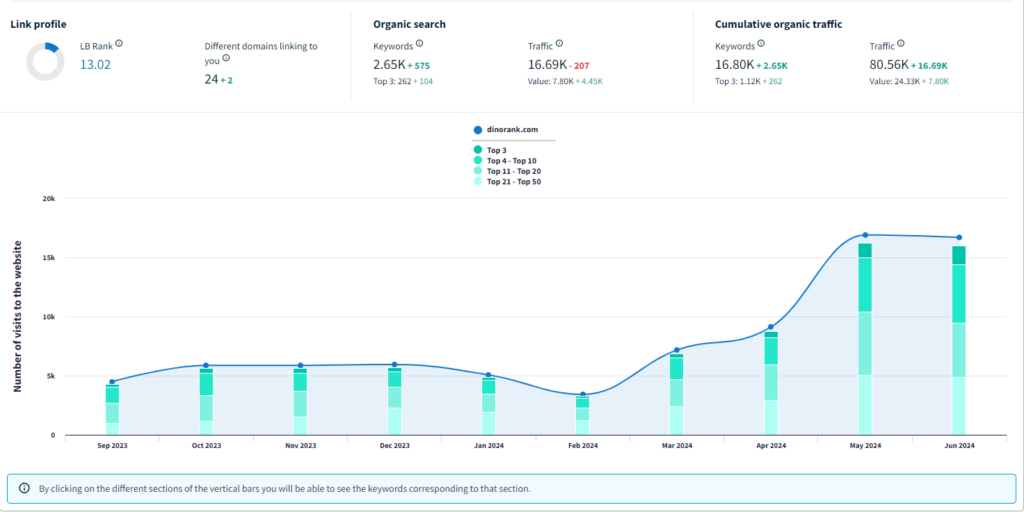
But the most interesting part is just below. If we review the keyword table and sort it by traffic, we can see which keywords are generating most of the revenue and whether there is room for improvement in the SERPs. We can also sort it by volume to discover high-potential business keywords.
Additionally, if we take any of these relevant keywords and run them through DinoRANK’s “Keyword Research” module, we will see who the closest competitors are and can analyze them later.
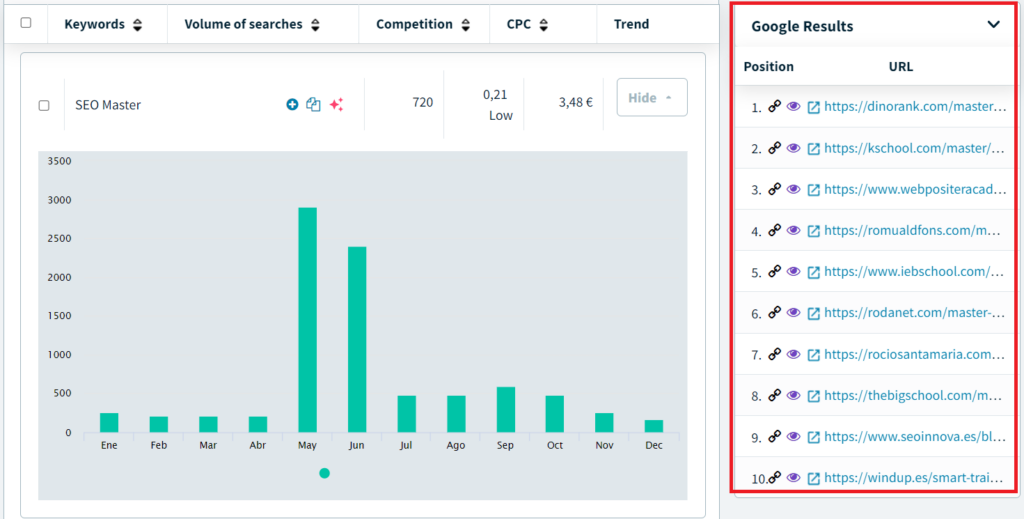
For this last point, DinoRANK has a very practical utility. It’s called “Content Gap” and it allows us to quickly detect keyword gaps.

These keywords that competitors are ranking for but our client is not, can be one of the main elements to include in our SEO proposal.
Technical Analysis of the Website
Another aspect you should review to understand your client’s starting point is whether their webpage has errors. With DinoRANK, you can run an On Page audit of the website in just a few minutes to check this point. It’s a basic analysis that is extremely useful for gathering data and preparing the SEO proposal.
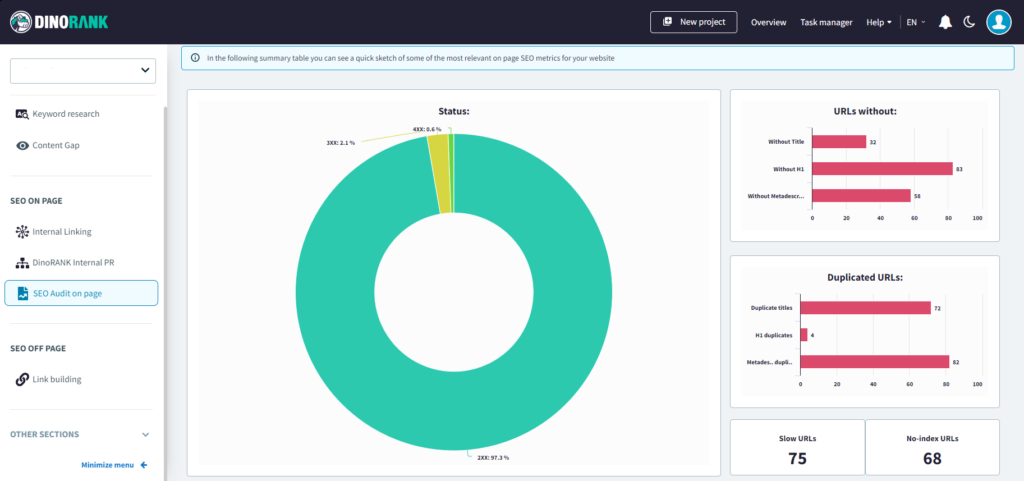
This small technical audit can be complemented with an analysis of the performance of the most important pages on the site using Google’s PageSpeed tool.
Link Profile Study
The last element I usually analyze in this preliminary SEO audit is the client’s website’s external link profile.
For this, I use the “Link Building” module of DinoRANK which allows me to see my client’s website backlinks, sort them based on their importance, and obtain a domain score based on the quality of those links.
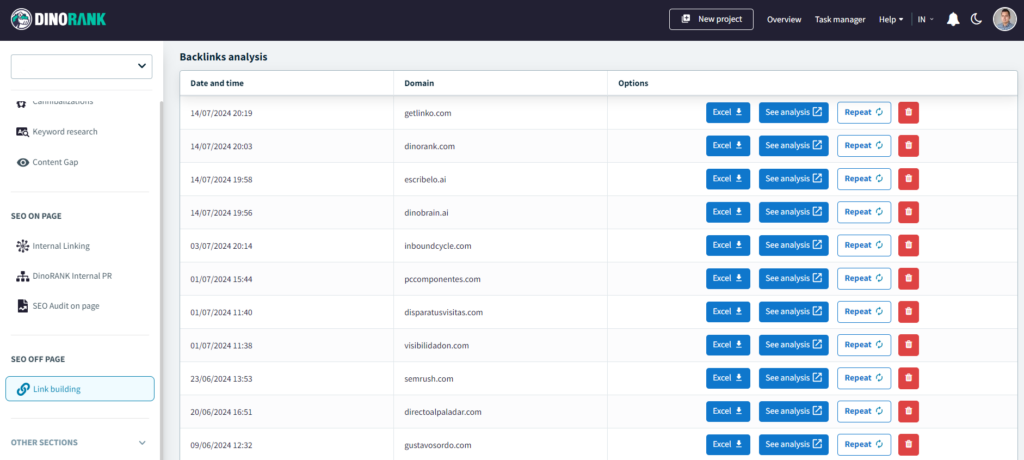
Then, I do the same with the main competitor websites. I compare their link metrics and analyze them along with their visibility graph.
When a competitor has more traffic, a higher number of ranked keywords, and better backlinks than my client, it can be a sign that the sector requires more authority to rank well, and therefore, that we need to optimize the link profile.
What a Personalized SEO Proposal Should Include
At this point, thanks to the preliminary audit, you should have enough information about your client to make an offer.
Let’s see then how to make this SEO proposal.
But first, I have to warn you that my intention is not to tell you how to fill out the sections of a typical SEO proposal, like those usually done by SEO agencies. The proposals I usually make are very personalized and tailored to each specific client.
Thus, each proposal tends to be different and follows a different structure or sections, but there are always some common elements which are the ones I will mention next.
Presentation
Your proposal should start with a brief introduction that allows your client to know who you are and, at the same time, piques their curiosity about what you want to propose.
And this is where many people go wrong, because they focus the discourse on themselves.
The objective of this presentation is not to tell how great you are, the degrees you have, or the awards you have won. The purpose of this part of your proposal is to make your client see that you understand their problems and that you know how to help them solve those issues.
Here is the translated text with the required adaptations and HTML formatting:
Es decir, focus the text on your client and not on yourself.
To do this, you will need to do some preliminary research on the market, the customer experience, their specific goals, etc., to tailor this presentation as closely as possible to their situation.
Obviously, you will also have to explain who you are, but very briefly and focusing on your experience within the sector. If you don’t have that experience, you can talk about other similar sectors or your work as an SEO.
In short, make sure the client feels that you are addressing them specifically and not sending them a template proposal that you’ve also sent to many other companies.
Structure of a Good Presentation:
- Briefly explain who you are and why you are sending the proposal.
- Discuss your experience in the client’s sector.
- Show your client that you know or have researched the market they operate in (size, difficulty, main competitors, etc.).
- Highlight the main challenges your client faces based on the characteristics of the market and the information you have about their business.
- Emphasize the key benefits the client will get from implementing your SEO solutions, without going into technical details.
- End with a call to action that invites the client to keep reading the full proposal to discover more details about your approach and solutions.
Current Situation and Identification of Opportunities
We have now reached the main part of our SEO proposal, the section where we will tell our client what problems we have found on their website and what benefits they can gain if we solve them.
To create this section, it is essential to have conducted the basic audit we discussed during the preliminary phase.
However, if we want our proposal to resonate with the client, we must be very cautious about the topics we propose and how we convey them.
Your client probably won’t be too happy if you point out their mistakes or what they did wrong. It’s better to talk to them about improvement opportunities and do so in terms they can understand. Here are some examples:
It often happens that there is a group of keywords that generate most of our client’s business and still have room for improvement in Google rankings. If we improve their positioning, we will likely see an increase in sales.
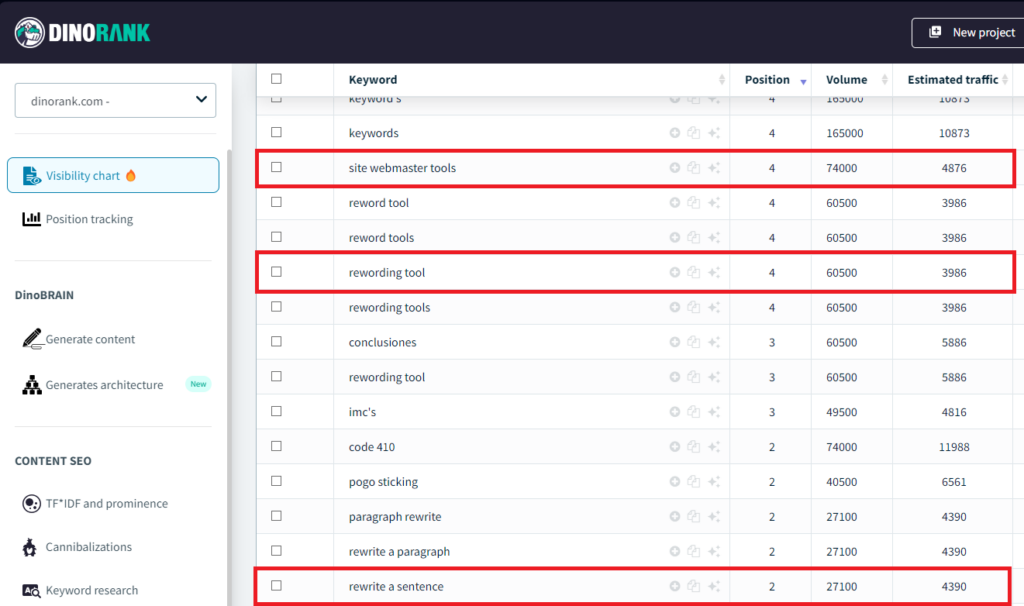
There may also be keywords that the competition ranks for with very high search volumes, but our client is not targeting them yet and could potentially do so.
Fixing technical errors on the website is often another opportunity for improvement, as it can help Google better rank the pages and enhance the user experience.
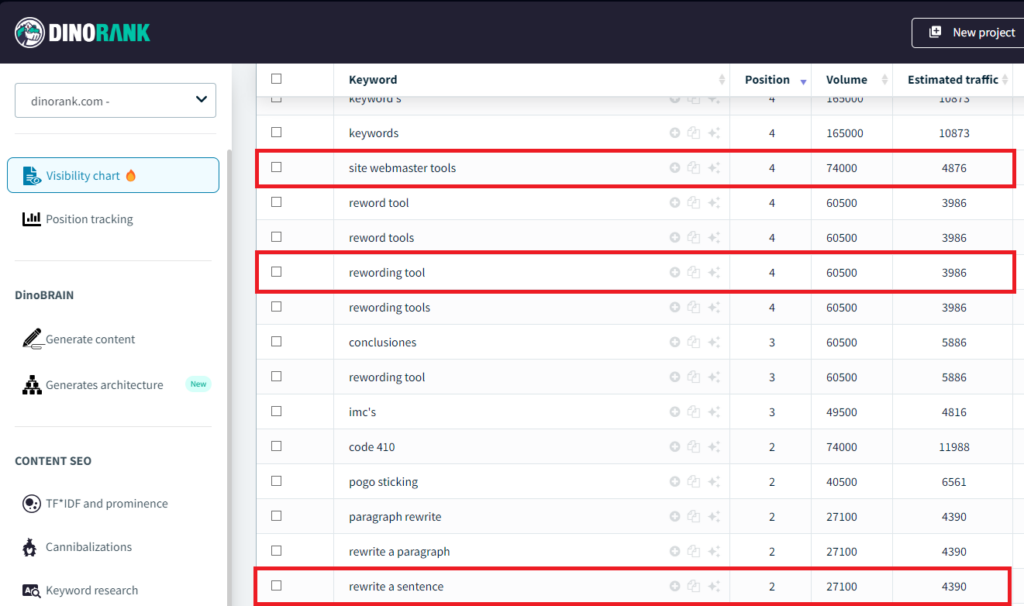
Another aspect that often catches the attention of many clients is checking the appearance of their pages within search results compared to their competitors and seeing how some can be more enticing for clicks than others.
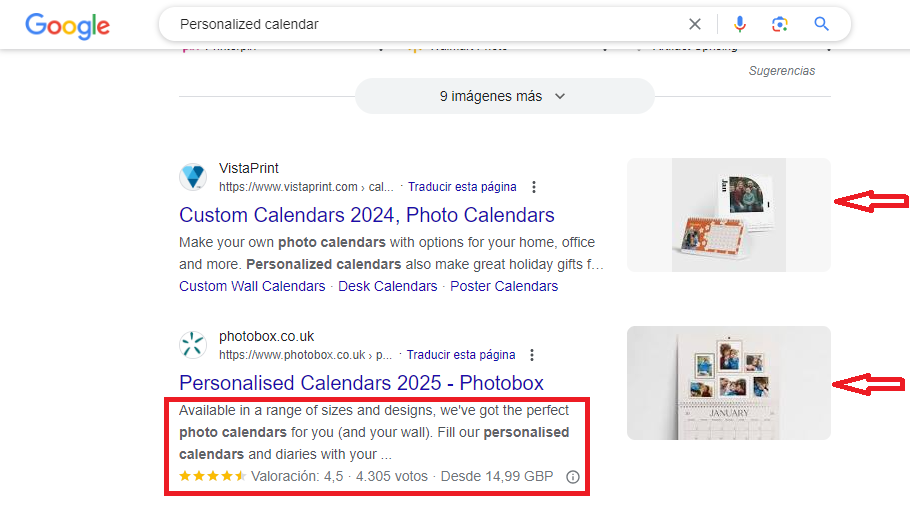
Or how the quality of backlinks affects ranking, especially when there are competitors ranking higher in the SERPs because of this factor.
In any case, it’s important not to go overboard with the number of improvements we propose to our clients, as we might overwhelm them and cause them to lose interest in our proposal.
As a guideline, I usually include between 1 and 3 opportunities in each proposal, the most important ones, so that the client can easily understand the value I want to bring.
Goals and specific actions to achieve them
Once we have presented the improvement opportunities for our client’s web project, it’s time to outline the goals we want to help them achieve.
To ensure the client perceives that our proposal has real value and we are not just selling them smoke and mirrors, these objectives should follow the so-called SMART criteria.
Characteristics of a SMART Objective:
- It should be clear and specific (Specific).
- It should be quantifiable to track progress (Measurable).
- It should be realistic and attainable (Achievable).
- It should be relevant to the business and aligned with its own goals (Relevant).
- It should have a defined timeframe (Time-bound).
Examples of SMART objectives in SEO would be:
- Increase the number of business-relevant keywords ranked in Google’s Top 10 by 20% over the next 12 months.
- Increase organic traffic by 30% over the next 12 months.
- Increase the click-through rate (CTR) by 15% over the next 6 months.
- Reduce the bounce rate by 10% over the next 3 months.
- Increase the number of quality backlinks by 25% over the next 8 months.
And finally, we need to indicate how we are going to achieve this. For example:
- To increase the number of ranked keywords, we will conduct keyword research, create new content, and optimize existing content.
- To increase organic traffic, in addition to the above, we will create topic clusters within the website to help rank key content.
- To increase the click-through rate (CTR), we will optimize titles and meta descriptions.
- To reduce the bounce rate, we will improve loading speed and user experience on the website.
- To increase the number of quality backlinks, we will implement an outreach strategy with other specialized websites.
Subsequent Phase: Reviewing Our SEO Proposal
Before sending the SEO proposal to your client, take a few minutes to read it over calmly and critically.
The goal is to self-evaluate the proposal to see if, strategically and based on what you know about your client, everything we propose makes sense.
Here is a checklist of some things you should verify.
SEO Proposal Evaluation Checklist:
- Make sure the proposal is personalized for your specific client. Mention specific details about their industry and website.
- Verify that the objectives are SMART.
- Ensure that the expected benefits for the client are clearly highlighted.
- Confirm that it has a logical structure and is easy to follow.
- Check that it is feasible, based on your experience, resources, and the competition’s difficulty.
How to Deliver Our SEO Proposal to a Client
The way we send our SEO proposal to the client varies depending on the relationship we have with them.
If it’s a client we’ve already worked with before or one who has called us for help, then the process is more straightforward.
On the other hand, when we are the ones reaching out to a potential client we don’t know to present our offer, we need to make an extra effort.
Next, I’ll explain these two possibilities in more detail.
Scenario 1: The client takes the initiative
This is the ideal situation because we already have a very important advantage from the start: the client is interested in our offer.
In these cases, I usually have a quick call with the client where they provide me with all the information I need to know about the domain to work on and the goals they want to achieve.
With that information, I conduct the initial analysis and prepare the SEO proposal, tailored to their request.
Afterwards, I send the proposal and schedule a meeting to discuss it. This is where we clarify all the details and address any questions.
Once the client has understood and validated the offer, I start preparing the budget, which typically has a very high acceptance rate because it closely matches what was agreed upon.
Scenario 2: We take the initiative
When your goal is to expand your client base by reaching out to companies you haven’t worked with as an SEO, it’s best to send them your proposal via email.
However, you can’t write this email casually. You need to put all your effort into creating a convincing email that grabs the attention of your potential client.
Remember what we discussed about presenting the proposal? Try to apply the same principles here to create a personalized and client-focused email.
Additionally, make sure to be direct and not overly verbose. An excessively long email can be off-putting and is more likely to end up in the trash.
A technique that usually works very well for me is sending a video where I discuss the most important aspects of the proposal. It’s a more dynamic way to convey the value of the offer and often leaves the recipient wanting to know more details.
End your email by suggesting to your potential client an in-person meeting, a video conference, or, in the worst case, a phone call to explain the proposal. If they say yes, you’ll have a lot won and the steps to follow from that moment will be similar to the previous scenario.
When is the budget prepared?
The budget is prepared once the client has accepted the proposal and understands the need for SEO in their project.
In other words, the client must first approve the proposal, which can be as we presented it or undergo changes based on what is discussed in the meeting with the client.
Once we have the client’s approval, we prepare the budget by estimating the cost of all the actions included and agreed upon within our SEO proposal.
Conclusions
A well-structured, client-focused SEO proposal can make the difference between closing a deal or not even getting a response.
As you have seen, it’s a process that takes time. But if you dedicate the necessary effort to making your proposal truly personalized, you will not only create a very positive impression on your clients but also greatly increase your chances of success.

